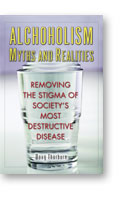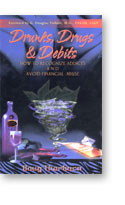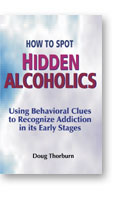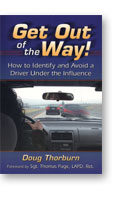 |

| December 2005 / Issue No. 16 |
 |
|
Welcome to the Thorburn Addiction Report. Each month, we bring you several sections, including:
1. Top Story of the month
2. Movie or Book Review of the month
3. Dear Doug in which a recent letter to "Dear Annie" or other "help" column is rewritten, with responses given from the unique perspective that alcohol or other drug addiction best explains the misbehaviors described
4. Alcoholic Myth-of-the-Month
5. Alcoholic Antic-of-the-Month
There is something for everyone!
|
|
Now is the time to place your holiday orders for my books, either through your favorite book store or my publisher, www.GaltPublishing.com. You could also help the cause of educating the public about the underlying cause of most of its problems by posting a review at www.Amazon.com or other on-line bookseller for any or all of my works. And by the way, the books are a terrific gift for young adults, providing tools for use in relationships—romantic and professional—that will last a lifetime.
Galt Publishing
|
|
Stanley “Tookie” Williams: A Model of Alcoholism, Horrific Behaviors, Sobriety and Possible Redemption
 Many recovering addicts do everything they can to redeem themselves. Does this mean they shouldn’t pay the price for committing the ultimate crime? Many recovering addicts do everything they can to redeem themselves. Does this mean they shouldn’t pay the price for committing the ultimate crime?
In 1981 Stanley “Tookie” Williams was convicted and sentenced to death for the 1979 murders of four people in two separate incidents. After the usual decades of appeals, he is scheduled for execution December 13, 2005. His unique case was chronicled in a 2004 movie and has provided fodder for weeks of talk-radio debate and bombast.
Williams, who grew up fatherless but with an apparent caring mother, began sniffing glue at age 13. He later became addicted to PCP, which causes extreme violence in some addicts, and used other drugs. Readers of my books know that the odds of alcoholism in illegal hard drug users are near 100%. In 1972 at age 18 he co-founded one of the world’s most notorious gangs, the Crips. There is little doubt that if he is innocent of the crimes for which he was convicted, he is guilty of numerous others. By his own admission, he was a troublemaker and criminal. When the verdict was read, he threatened the jurors. In prison he was involved in at least eleven serious incidents, including fights, throwing chemicals on guards and planning a violent jailbreak. For his continued troublemaking, he earned six years in solitary confinement beginning in 1988.
And his misbehaviors stopped abruptly after 1993. Why?
A return to civilized behaviors in addicts, particularly in those who have become especially uncivil, requires not only abstinence, but also ego deflation. Prison life is not amenable to opportunities to deflate the ego. Perhaps, solitary provided the necessary time to reflect. Maybe he read a few good books. He might have even read the comment in Alcoholics Anonymous by a nine-time inmate who said, “I wish everyone could be in A.A., and if everyone were, there would be no need for jails,” or another who said, “I served twelve years in prison, never suspecting that without alcohol, I would not have been in prison at all.” Tookie Williams could not have attended a 12-Step program while in solitary. He did, however, walk out an obviously changed man.
There are many arguments both for and against his guilt. Among them, supporters claim he had an unfair trial because there were no blacks on the jury—which is untrue. They point out that prosecutor Robert Martin described Williams, shackled in the defendant’s box, as a “Bengal tiger in captivity in a zoo.” Sorry, but that is an excellent and all-too-correct description of many addicts, especially those who smoke PCP, regardless of race. While detractors argue there is no question of his guilt, the 9th Circuit Court of Appeals, in suggesting that the Governor consider clemency, explained that the evidence supporting conviction was comprised of circumstantial evidence and witnesses had “less-than-clean backgrounds and incentives to lie in order to obtain leniency from the state in either charging or sentencing” in their cases. According to http://www.tookie.com/tookie_fact_sheet_10.18.05.pdf, one of the witnesses, a longtime felon placed in a nearby cell, testified that Tookie confessed to the crime after a police murder file on Williams’ case was left overnight with the informant. After facing a death sentence for rape, murder and mutilation, the informant was given a lesser sentence. On the other hand, the Los Angeles County District Attorney’s response to Williams’ petition for clemency is compelling (http://da.co.la.ca.us/pdf/swilliams.pdf), which includes mention of the fact that Williams seems to have known too many details about the crimes before they became public knowledge. And, of course he may have committed the murders: he was high on PCP at the time the crime was committed.
While never admitting guilt, with the help of journalist Barbara Cottman Becnel, Tookie Williams began a crusade against gangs, violence and drugs. He wrote nine books warning high-risk youth of the dangers of gangs. He apologized for founding the Crips and urged adolescents to shun gang life. If, as some talking heads suggest, he was doing this only to avoid execution, why didn’t he begin his crusade immediately after sentencing instead of threatening the jurors and continuing to create trouble among fellow inmates and prison guards for over a decade? Why did he wait until 1993 to become someone who virtually everyone agrees has since been a model prisoner?
On the other hand, he steadfastly refuses to admit guilt for the murders, claiming he cannot do so for a crime he did not commit. He’s between a rock and hard place: admitting guilt and apologizing to the victims, while an act of redemption, may reduce the odds of a court stepping in at the last moment to block the execution, or of clemency. All the same, he could consent to a debriefing, which would assist law enforcers in arrests by giving information on the Crips and how inmates get money and traffic in drugs. While claiming he has no information of value to offer, he says it would violate his “code of honor” to be debriefed—which he considers a euphemism for “snitching.” Yet, a code of honor is nothing more than a code of silence, which protects those who have committed criminal and unethical transgressions against others. Breaking the code helps other addicts experience consequences, thereby increasing the odds of sobriety in felons, as well as, perhaps, prison guards who assist felons acquire pruno (alcohol made from prunes in prison) and other drugs.
There are 647 condemned prisoners in California. If becoming a model prisoner is a way to turn over a conviction, get a retrial or be granted clemency, why doesn’t every convict write peace-affirming books or speak out against violence? The fact that Williams was a monster for a number of years while in prison indicates only that his drug-addled brain had not yet healed. Even if defective on some counts, he is clearly making an attempt at redemption and deserves a measure of commendation. The conundrum is this: offering clemency for a cold-blooded murderer is more than offset by the lack of mercy shown victims. However, redemption should be a life-long pursuit and dead felons cannot continue their work towards redemption, particularly valuable when that work may reduce the number of future victims. Although I wouldn’t want to be in Governor Schwarzenegger’s shoes at the hearing, clemency—life in prison without the possibility of parole—should be considered.
Runners-up for top story of the month:
Venezuelan de facto dictator Hugo Chavez, calling Mexican President Vicente Fox “a lapdog” of the U.S. at the Summit of the Americas in Mar del Plata, Argentina, after Fox argued in favor of global free trade. The Mexican government, which considered the attack “over the top,” recalled its ambassador from Venezuela and booted out the Venezuelan ambassador to Mexico.
Actor Robert Blake, found liable by a civil jury for “intentionally [causing] the death” of wife Bonny Lee Bakley and ordered to pay her children $30 million in damages. You’ll find the story of the criminal trial in the January 2005 edition of the Thorburn Addiction Report (http://www.addictionreport.com).
Prime Minister Tony Blair’s father-in-law Tony Booth, criticizing the British government for allowing pubs to serve liquor 24 hours a day. Booth explained he recognizes how close alcohol came to destroying him and says, “Some people will never be sober again.” On the other hand, the government will be cracking down on alcohol-fueled violence. This could prove an interesting experiment: will alcoholics bottom more quickly with the spigots turned on 24/7?
Dominick Maldonado, accused of a shooting spree at a crowded shopping mall in Tacoma, Washington, in possession of plans for making bombs and the poison ricin. His ex-girlfriend explained she had broken up with him “because of an issue with a drug.”
Soccer great George Best, dead from complications of alcoholism. With a reputation as a womanizer who was linked to some of the world’s most beautiful women, he was rumored to have slept with seven Miss Worlds, but admitted to only four because he “didn’t turn up for the other three.” He ran into trouble with the law, including the British taxing authorities, and was jailed for three months in 1983 for DUI, assault on a policeman and jumping bail. In a classic case of temporary control, after appearing “wildly” drunk on a live TV show in 1990, his second wife helped to contain his drinking by enough to allow him to appear regularly for a stretch as a soccer commentator. He was known to be unreliable in keeping his appointments as a player, TV soccer analyst and after-dinner speaker. He was described as “a talented soccer player, then a talented celebrity, tout de suite [in short order] a talented womanizer, and when all his other talents seem to have failed him, a talented drinker.” As usual, while he was no doubt destined to be an extraordinary soccer player, the description is at least partly backward: he was able to drink alcoholically, which drove him to inflate his ego as a celebrity and womanizer while allowing him to function extraordinarily well as a soccer player. Despite his talent, he was flat broke by middle age. Still, he had plenty of fans to enable him to his grave, as fans worldwide have done with so many. After decades of heavy drinking and a liver transplant in 2002, as a late-stage alcoholic he began drinking again and was banned from driving for 20 months after pleading guilty to DUI in 2004. In a recent update to his second autobiography he wrote, “Drink is the only opponent I’ve been unable to beat.” It is improbable that he mentioned the enigma that it also impelled him to win. He was 59.
Under watch:
Rep. Randy “Duke” Cunningham, a Vietnam War ace and eight-term congressman, who pleaded guilty to taking $2.4 million in bribes from defense contractors and others. The case against him grew from the sale of his home for $1,675,000 in Del Mar, California to a defense contractor in 2003, who sold it seven months later for a $700,000 loss in a booming California real estate market. This act, reported in this section several months ago, could be one of those, “Just what was he thinking?” moments in the annals of an alcoholism-fueled sense of invincibility. In his plea agreement, he admitted to being given $1,025,000 to pay down the mortgage on the home he bought after the Del Mar sale. He also made $400,000 selling his 65-foot flat bottom riverboat to New York developer Thomas Kontogiannis, on whose behalf Cunningham wrote a favorable letter to prosecutors investigating a bribery and kickback scheme involving school computer contracts.
Note to family, friends and fans of the above: the benefit of the doubt is given by assuming alcoholism (they are either idiots and fundamentally rotten, or they are alcoholic/other drug addicts—which would explain the misbehaviors). If alcoholic, there is zero chance that behaviors, in the long run, will improve without sobriety. An essential prerequisite to sobriety is the cessation of enabling, allowing pain and crises to build. Thus far, many have done everything they can to protect the addict from the requisite pain, making these news events possible. The cure for alcoholism, consequential bad behaviors and, ultimately, tragedy, is simple: stop protecting the addict from the logical consequences of the misbehaviors and proactively intervene.
Thorburn Substance Addiction Recognition Indicator
|
|
 Redemption: The Stan “Tookie” Williams Story Redemption: The Stan “Tookie” Williams Story
This well-acted 2004 film, originally on FX TV, is available on DVD. Jamie Fox plays Tookie Williams, with Lynn Whitfield playing a charming and appealing Barbara Becnel, who asks Tookie to provide her with information for her upcoming book on gang history. While admitting she holds gangs in contempt, she gets Tookie’s cooperation when she explains she intends to be objective and tell the truth about them, whatever the truth may be.
Tookie helped start the Crips to “protect the neighborhood.” Responding to Becnel’s comment that it was a criminal enterprise from the start, Tookie replies that the cops weren’t protecting anyone. “Either I was going to be a victim or a victimizer.” However, he failed to note that he’d been doing drugs since at least age 13 and he didn’t co-found the Crips until he was 18.
When Becnel asks, “How can you possibly justify shooting a man who looks just like you?” Williams responded, ”At the core is an embedded sense of self-hate…you start to believe those…stereotypes…depicting that the majority of blacks are buffoons or functioning illiterates, promiscuous, violent, welfare recipients [and] criminals…You lash out at those individuals that fit those stereotypes…trying to obliterate those negative images.” However, Tookie neglected to mention the drugs that cause distortions of perception and memory taken by most of those having such belief systems, including him.
He was too out-of-control for his mother, who took him to his father—whom he had never met—and who promptly abandoned him. While now eloquent and likeable, he didn’t remark on when he first used drugs—which may have been a period leading to his out-of-control behaviors.
Becnel put her history aside when Tookie told her, “I don’t want to leave my legacy here as simply being the co-founder of the Crips, if I can keep a kid from coming to this place…” He tells her he wants to right his wrongs by writing children’s books and shooting not people, but videos, in which he would apologize for his part in creating the Crips. “I deeply regret the legacy that it left because it left a legacy of genocide: black on black genocide.” While making it clear that the course of violence must be reversed, he again ignores the role of alcoholism and other-drug addiction in creating the mindset that leads to the lion’s share of abuse.
At one point, the film points out he stopped using when he decided to seek redemption. The link is blurred, but at least it’s there. He stopped using, which allowed him to seek redemption; redemption is impossible while still using, because the user-addict thinks he’s God.
What the movie lacks in forging the link between addiction and misbehaviors, it makes up for in speeches of atonement. “We do good because it makes us feel alive. The first half of my life I was dead…but now the second half I get a chance to live and do something about it. And if I have to die in order to show the meaning—the true meaning of it—then so let it be.” And, he points out the importance of self-responsibility in speeches to children: “This place [prison] does not make you a man. The moment you begin to make excuses for yourselves, that’s the moment you get on to a pathway leading straight to here.” And, “My violent gang past is unworthy of imitation or praise.” He admits his greatest mistake ever was to co-found the Crips, while explaining that life is all about choices and that to assume there wasn’t a choice is “just an excuse.”
It’s a good movie about redemption; we just can’t be sure, without meeting the man, how much is true. My understanding of alcoholism, however, has turned me into a strong believer in the idea of allowing addicts to do what they can to right their sometimes heinous wrongs. I wonder, with a strong likelihood he’s been clean and sober at least a dozen years, whether Tookie Williams shouldn’t be given the benefit of the doubt.
|
 |
Dear Doug: Monster Boy
Dear Doug:
My husband of 16 years and I have five well-behaved children. Everything was fine between our families until his brother married “Lenore” and they had a son, now 5 years old.
At family events, this little boy continuously bites, pulls hair and otherwise abuses his cousins. When we try to intervene, he goes after us. When we ask Lenore to use some discipline, she puts down her cigarette and tells him to stop. He laughs and continues abusing others.
The whole family has tried, but she makes excuses and insists that being stricter will bring on greater violence. When my husband finally told her that he will discipline the boy if she doesn’t, she became irate, threatened us with legal action and left obscene messages on our voice mail. Now our aging parents want us all together for the holidays. My children are begging not to go and I don’t want to put them—or ourselves—in harm’s way. What should we do?
Signed,
Aunt-in-law to a monster
. . . . .
Dear Aunt,
Other columnists might point out that the boy is crying out for discipline and that the parents (just where is his Dad in all this, anyway?) are abdicating. Such columnists would suggest parenting classes and behavioral counseling. They would completely ignore the fact that the combination of smoking, rearing an out-of-control child, making threats and mouthing obscenities reveals a very high likelihood that Lenore has alcoholism, which would render such classes and counseling worthless.
Your plan of action will depend upon whether she is the only addict and your husband’s brother is an extraordinarily passive enabler, or they are co-addicts. If he’s an enabler, since he has the greatest leverage in dealing with her, you will have to embark on some very quick educating. If they are both alcoholics, you can either let nature run its course out of their sights, or do everything possible to insure they experience consequences for misbehaviors, hoping to inspire sobriety before tragedy happens. Only when both are clean and sober, or one is out of their lives, will the child’s behavior have a chance of improving.
In the meantime, explain the problem to your parents and suggest that everyone cut off communication with the brother’s family until your plan of action is in place and progress has been made.
(Source for story idea: Annie’s Mailbox, November 28, 2005.)
|

“The young runaway’s memories of her cruel upbringing drove her to drugs,” wrote columnist Patricia Towle in the November 21, 2005 National Enquirer, about Oprah Winfrey’s surrogate daughter, 21-year-old Alexandra Molina. Oprah reportedly told Molina, “You’ve been through hell…All you need is somebody who believes in you….”
Regardless of whether or not true depending on your view of the Enquirer, the article promulgates far-reaching myths about alcoholism. If behaviors weren’t an issue, no one would bemoan the fact that someone had been driven to drugs. The implication in “drove her to drugs” is, therefore, “drove her to use drugs addictively.” Upbringing does not drive anyone to use drugs addictively. The fact that Molina was raised in a cruel manner indicates that those who raised her were alcohol or other-drug addicts, in which case she inherited an alcoholic biochemistry. If upbringing drove one to addiction, we would be able to teach non-addictive use. The idea that practicing addicts can be successfully counseled or environment causes addictive use is responsible for many an alcoholic’s experiments with attempts at controlling use, which inevitably leads to failure and a return of uncivil behaviors.
Further, the addict does not need somebody who believes in him or her. The addict often needs a program of recovery, to be sure—but more importantly, as many recovering alcoholics who never entered a formal program can attest, she needs to know she will be held accountable for misbehaviors. She needs to be told that if she uses, she will act badly some of the time.
Towle also reports that “a source explained that Alexandra’s slide into drugs was rooted deeply in her painful childhood.” If true, we would expect every child with access to drugs and a painful childhood to use addictively. The fact that a higher proportion of such children do so than would be expected by chance is due to the fact that a child of an alcoholic is four times more likely to become an addict than a child of a non-alcoholic, even when raised by non-alcoholic adoptive parents. Towle further reports on the source claiming, as if fact, “Alexandra turned to drugs to dull her pain.” The next time, Towle might want to cite a different source, which would report, “Alexandra turned to drugs to dull her pain, because she processes drugs in a way that allows her to do so.” The rest of us sometimes wish we could dull our pain with drugs. Alas, we go through life unable to do so, briefly envious of those who can, until we remember the vast cesspool that ultimately results.
|

Amazing Antics: Stories of Alcoholism-Driven Behaviors™
The case of Duke Cunningham reminded me of some recent antics reported in Randy Cassingham’s “This is True” that are perfect for posing the question, “Just what was he or she thinking?” In the first, we have proof of addiction and evidence of relapse; in the second, no proof but, well, “Just what was he thinking?” if he wasn’t under the influence?
Stories from “This is True” by Randy Cassingham, with his “tagline:”
“LEADING BY EXAMPLE: Florida state Sen. Mandy Dawson wanted to join fellow legislators on a trip to Africa. The others paid their own ways, but Dawson ordered an aide to solicit donations for the trip from lobbyists. When her aide told her that was against the law, she ordered the aide to do it anyway. Dawson was previously in trouble for altering a prescription to get extra painkillers, but avoided prison by going to drug rehab. This time, for soliciting and accepting cash, she was reprimanded in public by the Senate—and kicked off the Senate ethics committee. ‘I hope you will accept my humble and sincere apology if my actions have in any way compromised the integrity of this body,’ she said. (Miami Herald) ...If?”
“FACE THE MUSIC III: While performing in a musical in a community theater, Jay Meisenhelder ‘fell in love’ with a fellow actress. She is 16. ‘I'm 53-years-old, and believe me, I know what love is,’ he wrote her in an e-mail. ‘I love you as I have only loved two other women in my life.’ He also met the girl for a candle-lit music session. When his boss found out about the e-mail, apparently sent from work, and the meeting, Meisenhelder was fired from his job—as the Marion County, Ind., deputy prosecutor and assistant chief of the sex crimes division. Meisenhelder, who is married, insists ‘nothing I did was illegal.’ His lawyer agrees: Meisenhelder was just ‘expressing a fantasy,’ attorney Roberta Ross says. ‘What they essentially chose to do was take an excellent eight-year employee who lived and breathed and loved his job and dramatically overreacted.’ (Indianapolis Star) ...Yes, well, his breathing just got too heavy for the public to stomach.”
(Stories from “This is True,” copyright 2005 by Randy Cassingham, used with permission. See http://www.thisistrue.com for free subscriptions.)
Visit www.thisistrue.com for free subscriptions.
|
Comments
To view reader's comments on last month's Thorburn Addiction Report and Doug's responses please visit the Thorburn Weblog at PrevenTragedy.com.
Doug frequently posts alcoholism-related articles, as well as his responses, so be sure to check back often.
Thorburn Weblog
|
Doug's new book, Alcoholism Myths and Realities, is available pre-publication to
our readers only and has already received rave reviews including:
"Every policymaker in America needs to read your book exposing the myths of chemical addiction...Excellent book."
— Jim Ramstad, Member of U.S. Congress (MN)
"My father died of alcoholism. His father died of alcoholism. Three generations of alcoholism is enough. Now is the time to abandon superstition and pseudoscience, to debunk the myths surrounding alcoholism, and to apply science to solving this problem. Doug Thorburn's book is a model example of how this should be done. Read it and be prepared to change your thinking on this important topic. When enough of us understand what is really going on with alcoholism, society can make the shift from treatment to prevention and intervention."
— Michael Shermer, publisher, Skeptic Magazine and columnist, Scientific American
Buy your copy of Alcoholism Myths and Realities now, before the general public can in June for only $14.95. Or get the whole collection of Doug's books PLUS a two-hour audio cassette of Doug's presentation on "Identifying early stage alcoholics, and why families and friends just don't get it," for just $49.95 plus tax and shipping. That's a $72.75 value for only $49.95.
To order online, click the following link (be sure to put "TAR SPECIAL" in the comments section of the order form.) Orders can also be placed by phone: 800-482-9424 OR fax: 818-363-3111.
If you wish to pay by check, send the appropriate payment with your shipping information and the words "TAR SPECIAL" in the "memo" section of your check to: PO Box 7777, Northridge, CA 91327.
To purchase any of the above Thorburn books, go to www.galtpublishing.com |

Have you visited the Prevent Tragedy Foundation? The Prevent Tragedy Foundation is a tax-exempt 501c-3 organization, the goal of which is to educate the general public on the need for early detection of alcohol and other drug addiction. The Foundation is intended to answer a question that has been all-but-ignored by similar organizations: what does alcoholism look like before it becomes obvious?
Click here to visit the Prevent Tragedy Foundation |
The Thorburn Addiction Report is available to newspapers as a regular feature column.
Inquiries are invited.
Copyright 2005 Doug Thorburn All Rights Reserved.
ALL broadcast, publication, retransmission to e-mail lists, WWW or any other copying or storage, in any medium, online or not, is strictly prohibited without prior written permission from the author. Manual forwarding by e-mail to friends is allowed if 1) the newsletter is forwarded in its entirety and 2) no fee is charged. Please forward no more than three issues to any one person -- after that, they should get their own free subscription. We appreciate people who report violations of our copyright to us.
TO COMMENT to the author,
send your email to report@preventragedy.com or write to
Doug Thorburn, P.O. Box 7777, Northridge, CA 91327-7777
|
 |





 Many recovering addicts do everything they can to redeem themselves. Does this mean they shouldn’t pay the price for committing the ultimate crime?
Many recovering addicts do everything they can to redeem themselves. Does this mean they shouldn’t pay the price for committing the ultimate crime? Redemption: The Stan “Tookie” Williams Story
Redemption: The Stan “Tookie” Williams Story



